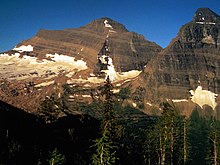Belt Supergroup
| Belt Supergroup Stratigraphic range: Mesoproterozoic |
|
|---|---|

Belt Supergroup strata exposed on Kintla Peak in Glacier National Park.
|
|
| Type | Geological supergroup |
| Sub-units | Many |
| Underlies | Flathead Formation |
| Overlies | Archean and Paleoproterozoic rocks |
| Thickness | more than 15 kilometres (10 mi) |
| Lithology | |
| Primary | Mudstone, argillite |
| Other | Sandstone, quartzite, conglomerate, intrusive rocks |
| Location | |
| Region | Montana, Idaho, Washington, Wyoming |
| Country | United States |
| Type section | |
| Named for | Big Belt Mountains, Montana |
The Belt Supergroup is an assemblage of primarily fine-grained sedimentary rocks and mafic intrusive rocks of late Precambrian (Mesoproterozoic) age. It is more than 15 kilometres (10 mi) thick, covers an area of some 200,000 km2 (77,220 sq. mi), and is considered to be one of the world's best-exposed and most accessible sequences of Mesoproterozoic rocks. It was named after the Big Belt Mountains in west-central Montana. It is present in western Montana and northern Idaho, with minor occurrences in northwestern Washington and western Wyoming. It extends into Canada where the equivalent rocks are called the Purcell Supergroup and are exposed in southeastern British Columbia and southwestern Alberta. Spectacular outcrops of Belt rocks can be seen in Glacier National Park in northwestern Montana and in Waterton Lakes National Park in southwestern Alberta.
The Belt Supergroup is dominated by fine-grained sedimentary rocks, primarily mudstones, siltstones, fine-grained quartzose sandstones and limestones. Most have undergone weak metamorphism to greenschist facies, and as a result the mudrocks are commonly classified as argillites and the sandstones as quartzites. The Belt Supergroup also includes lesser amounts of coarser grained sandstones and conglomerates.Mafic intrusive rocks are present locally in the lower portion.
...
Wikipedia
